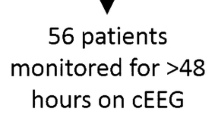Abstract
Background/objective
Intravenous (IV) lacosamide use for status epilepticus has increased in recent years and is recommended for refractory status epilepticus by current guidelines. Per the lacosamide package labeling, the preferred route of administration is diluted and infused over 30–60 min; however, administration undiluted is also acceptable and recent literature demonstrated safety at a maximum rate of 80 mg per minute (Kellinghaus et al. in Acta Neurol Scand 123:137–141, 2011). Undiluted administration as an IV push has potential to increase efficiency of administration to patients needing urgent seizure control since it may be dispensed from automatic dispensing cabinets in patient care areas. This study aims to compare safety outcomes and efficiency of administration in patients receiving lacosamide IV push compared to IV piggyback.
Methods
We present a single-center, retrospective cohort study of patients receiving lacosamide via IV piggyback or IV push from June 2016 to July 2017. Baseline characteristics, data related to potential safety concerns and timing of ordering, verification, and administration were collected. The primary safety outcomes were incidence of infusion site reactions, hypotension (systolic blood pressure [SBP] < 90 mm Hg), and bradycardia (heart rate [HR] < 50 beats per minute) documented within 2 h of each lacosamide dose. Secondary safety outcomes included the incidence of PR interval prolongation in patients with at least one electrocardiogram measured. The primary efficiency outcome was the time between order verification and administration.
Results
Patients in the IV piggyback (n = 88) and IV push (n = 78) groups had similar baseline characteristics, initial dose, SBP, and HR. Hypotension (8 vs. 10.3%) and bradycardia (2.3 vs. 2.6%) rates were similar among both groups (p > 0.05). Only one patient in each group had documented PR prolongation, and no documented infusion reactions occurred. Median time from order verification to administration was significantly reduced in the IV push group (35 min vs. 1 h 49 min; p < 0.001).
Conclusions
Administration of lacosamide via IV push results in similar adverse effect rates to IV piggyback preparations with more efficient time to administration.
Similar content being viewed by others
References
Kellinghaus C, Berning S, Immisch I, et al. Intravenous lacosamide for treatment of status epilepticus. Acta Neurol Scand. 2011;123:137–41.
Brophy GM, Bell R, Claassen J, et al. Guidelines for the evaluation and management of status epilepticus. Neurocrit Care. 2012;17:3–23.
Vimpat (lacosamide) [prescribing information]. Smyrna, GA: ICB Inc; 2017.
Misra UK, Dubey D, Kalita J. Comparison of lacosamide versus sodium valproate in status epilepticus: a pilot study. Epilepsy Behav. 2017;76:110–3.
Newey CR, Le NM, Ahrens C, Sahota P, Hantus S. The Safety and effectiveness of intravenous lacosamide for refractory status epilepticus in the critically ill. Neurocrit Care. 2017;26:273–9.
Goodwin H, Hinson HE, Shermock KM, Karanjia N, Lewin JJ 3rd. The use of lacosamide in refractory status epilepticus. Neurocrit Care. 2011;14:348–53.
Hofler J, Unterberger I, Dobesberger J, Kuchukhidze G, Walser G, Trinka E. Intravenous lacosamide in status epilepticus and seizure clusters. Epilepsia. 2011;52:e148–52.
Krause LU, Brodowski KO, Kellinghaus C. Atrioventricular block following lacosamide intoxication. Epilepsy Behav. 2011;20:725–7.
Kellinghaus C, Berning S, Besselmann M. Intravenous lacosamide as successful treatment for nonconvulsive status epilepticus after failure of first-line therapy. Epilepsy Behav. 2009;14:429–31.
Small-volume parenteral solutions shortages. American Society of Health System Pharmacists. 2017. http://www.ashp.org/Drug-Shortages/Shortage-Resources/Publications/Small-Volume-Parenteral-Solutions-Shortages. Accessed 16 Jan 2018.
Safe practice guidelines for adult IV push medications. ISMP. 2015. http://www.ismp.org/Tools/guidelines/IVSummitPush/IVPushMedGuidelines.pdf. Accessed 16 Jan 2018.
Author Contributions
KED is responsible for design of the study, acquisition, analysis and interpretation of data as well as drafting, revising, and final manuscript approval; JN, responsible for acquisition of data and final manuscript approval; KAA, responsible for conceptual design of the work and final manuscript approval; JK, responsible for conceptual design and implementation of the work, revising, and final manuscript approval; and GMJ, responsible for conceptual design of study, analysis and interpretation of data, as well as drafting, revising, and final manuscript approval.
Funding
No funds were used for the completion of this research.
Author information
Authors and Affiliations
Corresponding author
Ethics declarations
Conflict of interest
All authors declare that they have no conflict of interest to disclose.
Ethical Approval
All data were extracted from the electronic medical record, and the study was approved by the University of Tennessee Institutional Review Board.
Rights and permissions
About this article
Cite this article
Davidson, K.E., Newell, J., Alsherbini, K. et al. Safety and Efficiency of Intravenous Push Lacosamide Administration. Neurocrit Care 29, 491–495 (2018). https://doi.org/10.1007/s12028-018-0560-6
Published:
Issue Date:
DOI: https://doi.org/10.1007/s12028-018-0560-6




